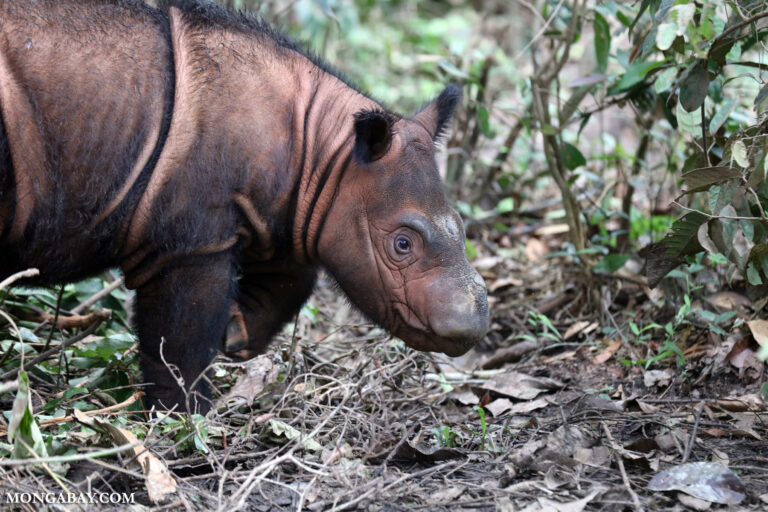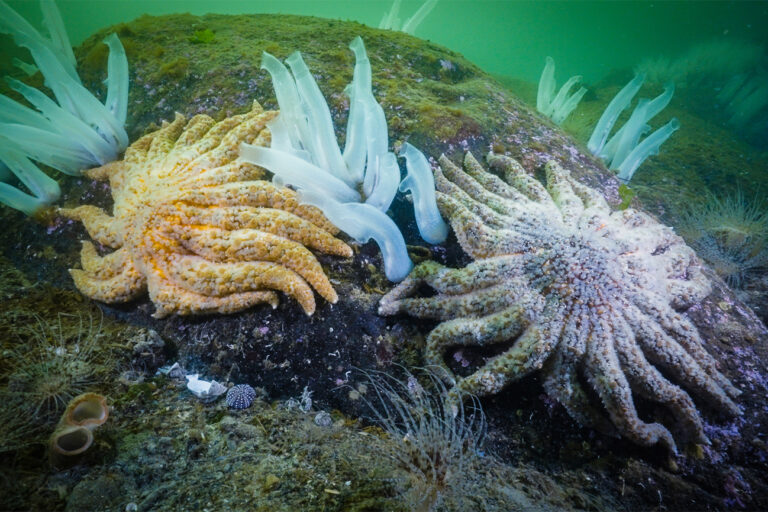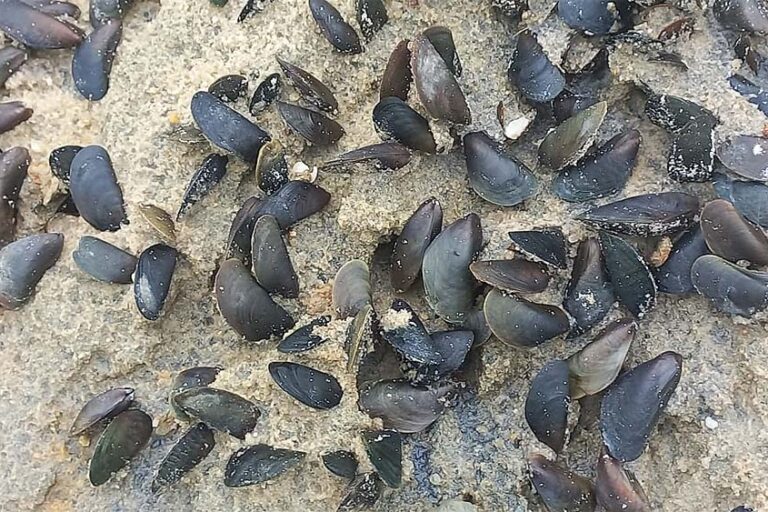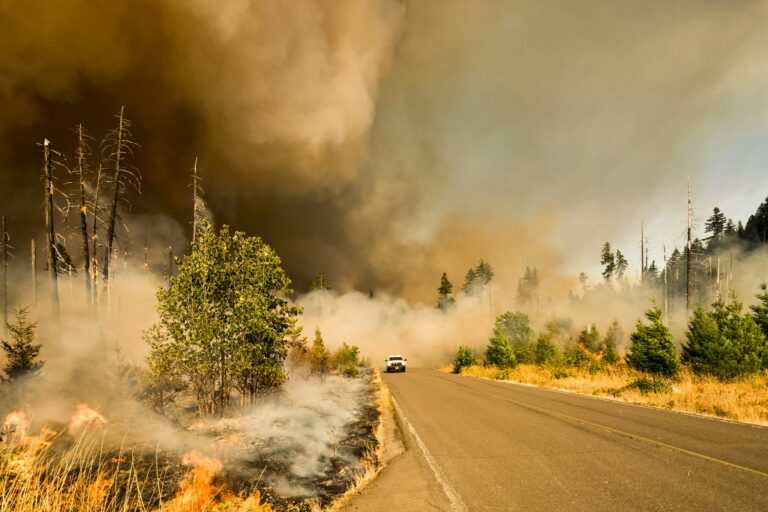Environmental concerns mount as palm oil production surges
Environmental concerns mount as palm oil production surges
Key points on the environmental impact of palm oil
Rhett A. Butler, mongabay.com
May 15, 2007
The booming market for palm oil is driving record production but fueling rising concerns over the environmental impact of the supposedly “green” bioenergy source.
The two leading producers of palm oil, Malaysia and Indonesia, have rapidly expanded palm oil production in recent years, often at the expense of biodiverse rainforests and carbon-rich peatlands that store billions of tons of greenhouse gases. Environmentalists say that due to these factors, burning of palm oil can at times be more damaging the global climate than the use of fossil fuels.
“As much as 2000 million tonnes of carbon dioxide are released annually from just the logged and drained peatlands of South-east Asia; 8% of all global emissions,” said Marcel Silvius of Wetlands International, an environmental group that has analyzed the climate impact of peatlands destruction in Indonesian. “Over 50% of new plantations are allocated on peatlands. As such palm oil is a major driver in the further destruction of the remaining peat swamp forests and a significant cause for global CO2 emissions.”
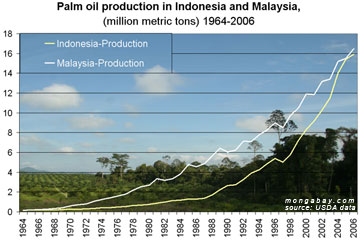 Chart showing annual palm oil production by Malaysia and Indonesia from 1964-2006. Click to enlarge. |
European governments have recently expressed concern over the apparent unsustainably of oil palm cultivation in peatlands. Last week Dutch minister of the Environment, Jacqueline Cramer, finalized a framework that set guidelines for the sustainable production of palm oil. While the initiative is non-binding in order to skirt World Trade Organization (WTO) regulations, it could set a precedent for other European nations to follow. The U.N. has also introduced language on palm oil production.
Both European governments and the U.N. are looking at the example set forth by the Roundtable on Sustainable Palm Oil, an industry group that seeks to cultivate oil palm can in a manner that helps mitigate climate change, preserves biodiversity, and brings economic opportunities to desperately poor rural populations.
Palm Oil Production in Malaysia and Indonesia
In Malaysia oil palm production has risen from 151,000 metric tons in 1964 to 16.5 million metric tons in 2006. Over the same period, exports have climbed from 141,000 metric tons to 13.1 million metric tons. Oil palm plantations grew from 60,000 hectares in 1960 to more than 3 million hectares in 2001. In 2004, 43% of these of these were located in Sabah and Sarawak, on the island of Borneo. However, because virtually all suitable land is used in Peninsular Malaysia, expansion is expected mostly to occur in Malaysian Borneo and, to a greater extent, Kalimantan. Oil palm cultivation has increased from 186,744 hectares in Sabah and Sarawak in 1984 to 1,673,721 hectares at the close of 2003.
Between 1964 and 2006 Indonesian oil palm production has increased from 157,000 metric tons to 15.9 million metric tons while exports have jumped from 126,000 metric tons to 11.6 million metric tons. In Indonesian Borneo, Kalimantan, oil palm plantations have expanded from 13,140 hectares in 1984 to nearly one million hectares at the end of 2003. Overall, oil palm cultivation has expanded in Indonesia from 600,000 hectares in 1985 to more than 6 million hectares by early 2007, and is expected to reach 10 million hectares by 2010.
The oil palm
Palm oil is derived from the plant’s fruit, which grow in clusters that may weigh 40-50 kilograms. A hundred kilograms of oil seeds typically produce 20 kilograms of oil, while a single hectare of oil palm may yield 5,000 kilograms of crude oil, or nearly 6,000 liters of crude oil that can be used in biodiesel production. At $400 per metric ton, or about $54 per barrel, palm oil is competitive with conventional oil. In the future, palm oil prices are expected to fall further as more oil palm comes under cultivation.
More charts
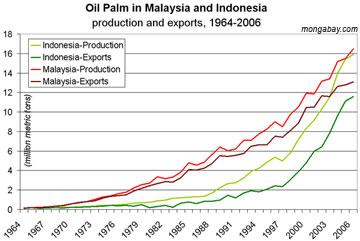
Chart showing annual palm oil production and exports by Malaysia and Indonesia from 1964-2006. Click to enlarge.

Chart showing annual palm oil production and exports for Malaysia from 1964-2006. Click to enlarge.
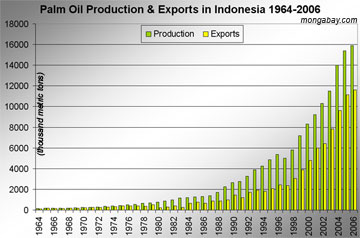
Chart showing annual palm oil production and exports for Indonesia from 1964-2006. Click to enlarge.
Further reading (palm oil blog for updates)
Dutch plan restricts biofuels that damage environment
(4/29/2007) The Netherlands has proposed a system to reduce the environmental impact of biofuels production. The country becomes the first in the world to establish such guidelines. Environmentalists have expressed increasing concern for the establishment of energy crops in biodiverse and carbon-rich ecosystems like the peatlands of Indonesia and the Amazon rainforest. They say that conversion of these forests for oil palm and soybeans is threatening endangered species and worsening global warming. Further, they warn, demand for such biomass energy products is driving up prices for food crops.
Dutch will demand rainforest-friendly palm oil
(4/27/2007) In a report scheduled to be released today, the Dutch government will outline criteria for growing biofuels in a more sustainable manner. The guidelines will be closely watched by the rest of Europe, which is currently struggling with the environmental pros and cons of large-scale energy crop production, especially in ecologically-sensitive areas like the Amazon and Indonesian rainforests.
Palm oil doesn't have to be bad for the environment
(4/4/2007) As traditionally practiced in southeast Asia, oil palm cultivation is responsible for widespread deforestation that reduces biodiversity, degrades important ecological services, worsens climate change, and traps workers in inequitable conditions sometimes analogous to slavery. This doesn't have to be the case. Following examples set forth by the Roundtable on Sustainable Palm Oil and firms like Golden Hope Plantations Berhad, a Malaysian palm oil producer, oil palm can be cultivated in a manner that helps mitigate climate change, preserves biodiversity, and brings economic opportunities to desperately poor rural populations.
Eco-friendly palm oil could help alleviate poverty in Indonesia
(4/3/2007) The Associated Press (AP) recently quoted Marcel Silvius, a climate expert at Wetlands International in the Netherlands, as saying palm oil is a failure as a biofuel. This would be a misleading statement and one that doesn't help efforts to devise a workable solution to the multiplicity of issues surrounding the use of palm oil.
Indonesia is 3rd largest greenhouse gas producer due to deforestation
(3/26/2007) Indonesia trails only the United States and China in greenhouse gas emissions, reports a study released Friday by the World Bank and the British government.
Borneo
(2/22/2007) Borneo, the third largest island in the world, was once covered with dense rainforests. With swampy coastal areas fringed with mangrove forests and a mountainous interior, much of the terrain was virtually impassable and unexplored. Headhunters ruled the remote parts of the island until a century ago. In the 1980s and 1990s Borneo underwent a remarkable transition. Its forests were leveled at a rate unparallel in human history. Borneo's rainforests went to industrialized countries like Japan and the United States in the form of garden furniture, paper pulp and chopsticks. Initially most of the timber was taken from the Malaysian part of the island in the northern states of Sabah and Sarawak. Later forests in the southern part of Borneo, an area belonging to Indonesia and known as Kalimantan, became the primary source for tropical timber. Today the forests of Borneo are but a shadow of those of legend and those that remain are highly threatened by the emerging biofuels market, specifically, oil palm.
Biofuels could decimate environment, stymie developing countries, says report
(1/25/2007) In his State of the Union Address Tuesday night, U.S. President George W. Bush highlighted ethanol fuel production as a means to improve domestic security by reducing dependence on foreign oil while at the same time helping to fight global warming. His call echoes a broader shift in sentiment among business and political leaders who believe that biofuels — liquid fuels produced 'energy crops' including sugarcane, corn, soybeans, oil palms — are a key future liquid energy source. In fact, next week, biofuels are likely to take a prominent position at the European Union's 'Sustainable Energy Week' in Brussels when 650 delegates will listen to speeches by the likes of Al Gore and UK foreign minister Margaret Beckett. With all the enthusiasm it may seem that biofuels are the end-all solution. A new report argues that this is not the case. In its briefing, 'International trade in biofuels: Good for development? And good for environment?' the International Institute for Environment and Development (IIED) cautions policymakers not to get caught up in all the hype. IIED warns that serious concerns still remain when it comes to the widespread adoption of these renewable energy sources.
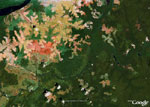 |
China invests in $5.5B biofuels project in Borneo, New Guinea
(1/18/2007) China has agreed to invest in a $5.5 billion biofuels project on the islands of New Guinea and Borneo. The plan promises to be controversial among environmentalists who say that it will destroy some of the world's most biodiverse — and threatened — ecosystems on the planet.
Borneo governor arrested in rainforest for palm oil fraud
(12/20/2006) The governor of East Kalimantan on Indonesian part of the island of Borneo has been suspended and faces life in prison for his involvement in an oil palm plantation scheme that caused the deforestation of a million hectares of tropical rainforest.
Why is palm oil replacing tropical rainforests?
(4/25/2006) In a word, economics, though deeper analysis of a proposal in Indonesia suggests that oil palm development might be a cover for something more lucrative: logging. Recently much has been made about the conversion of Asia's biodiverse rainforests for oil-palm cultivation. Environmental organizations have warned that by eating foods that use palm oil as an ingredient, Western consumers are directly fueling the destruction of orangutan habitat and sensitive ecosystems. So, why is it that oil-palm plantations now cover millions of hectares across Malaysia, Indonesia, and Thailand? Why has oil palm become the world's number one fruit crop, trouncing its nearest competitor, the humble banana? The answer lies in the crop's unparalleled productivity. Simply put, oil palm is the most productive oil seed in the world. A single hectare of oil palm may yield 5,000 kilograms of crude oil, or nearly 6,000 liters of crude.
Borneo rainforest protected, oil palm plantation canceled
(3/28/2006) Today Indonesia announced its would end plans to establish a 1.8 million hectare oil plantation in the rainforest of Borneo. The proposed plan, which was backed by Chinese investments, would have destroyed one of the most biodiverse ecosystems on Earth.







